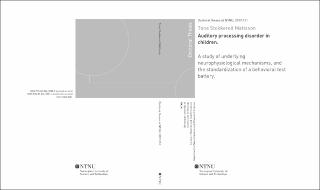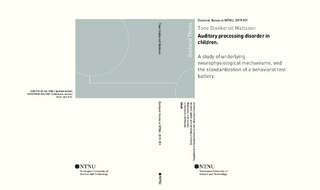| dc.contributor.advisor | Nordgård, Ståle | |
| dc.contributor.advisor | Andersson, Stein | |
| dc.contributor.advisor | Lind, Ola | |
| dc.contributor.author | Mattsson, Tone Stokkereit | |
| dc.date.accessioned | 2019-09-30T14:10:30Z | |
| dc.date.available | 2019-09-30T14:10:30Z | |
| dc.date.issued | 2019 | |
| dc.identifier.isbn | 978-82-326-3901-4 | |
| dc.identifier.issn | 1503-8181 | |
| dc.identifier.uri | http://hdl.handle.net/11250/2619445 | |
| dc.description.abstract | Auditory processing disorder in children.
A study of underlying neurophysiological mechanisms, and the standardization of a behavioural test battery.
Individuals with auditory processing disorder (APD) typically report listening difficulties in challenging auditory environments, despite a normal audiogram. APD has been regarded as a disorder in the bottom-up perceptual processing of auditory information in the central auditory nervous system (CANS), and the neurobiological activity that underlies that processing (American Speech-Language Hearing Assosiation, 2005). APD is separate from, but can co-exist with disorders in top-down processes related to cognition and/or language. Recently, this view has been challenged by the notion that APD may include both auditory and cognitive elements, thus advocating the need for a multi-disciplinary approach to diagnosis of APD.
As APD covers several aspects of audition, one test alone cannot address all dimensions of APD, and a battery approach with several behavioural tests for auditory processing (AP) is needed. A number of existing behavioural tests developed for English-speaking populations were considered, and based on the work of Brandt (2010), the Norwegian AP test battery was developed.
Processing of the auditory signal in the CANS is complex and the mechanisms leading to listening difficulties are still poorly understood. Otoacoustic emissions and electrophysiological methods may complement each other by providing a window into the mechanisms underlying auditory processing, from the cochlea to the auditory cortex and back down to the brainstem and ear. The medial olivocochlear reflex (MOCR) is thought to aid speech discrimination (particularly in noise) by selectively inhibiting cochlear amplification. Deficits in the central auditory efferent system, as reflected by reduced suppression of transient evoked otoacoustic emission (TEOAE) with contralateral noise, may be the cause of listening difficulties in background noise found in children with APD.
The auditory middle latency response (AMLR) and the auditory late latency response (ALLR) have been used to assess neural function in the thalamo-cortical pathways essential for processing speech and non-speech signals, and elementary levels of auditory sensory coding and automatic processing, respectively. The P300 has been used to assess discriminative responses thought to represent cognitive processes involved in conscious recognition, attention and discrimination of the acoustic characteristics of the stimuli.
This thesis includes three papers focusing on the underlying neurophysiological mechanisms and diagnostics of auditory processing in children. The aim of paper 1 was to standardise the Norwegian AP test battery for children aged 7-12 years. Normative data were obtained from 268 children with normal hearing, the test-retest reliability was examined and a final AP test battery was presented.
For papers 2 and 3 the study population included 46 children aged 8-14 years with normal peripheral hearing, divided into three groups based on AP assessment: i) children with listening difficulties and APD, ii) children with listening difficulties without APD, and iii) children with normal hearing and no listening difficulties. Some of the children with listening difficulties had comorbid disorders, such as attention disorders, autism or language disorders.
The aim of paper 2 was to investigate the suppression of otoacoustic emissions in children with listening difficulties. No significant group difference was observed for contralateral TEOAE suppression in children with APD, children with listening difficulties (without APD) and children with normal hearing, indicating normal medial olivocochlear (MOC) function. The results did not support the hypothesized link between reduced contralateral suppression of TEOAE and listening difficulties in the presence of background noise in this sample of children with APD.
The third paper aimed at investigating neurobiological aspects of early and late auditory processing and their relationships with AP performance and cognitive function. Three auditory evoked electrophysiological tests that have been widely used to investigate both auditory and nonauditory systems were used; the auditory middle latency response (AMLR), the auditory late latency response (ALLR) and the auditory P300, and the Integrated Visual and Auditory Continuous Performance Test plus (IVA+). Abnormal AMLR and P300 results were found in children with listening difficulties, with or without APD, compared to normal hearing children. However, no difference was observed between the two groups of children with listening difficulties. This indicate that impaired thalamo-cortical (bottom up) and neurocognitive function (top down) may contribute to difficulties discriminating speech and non-speech sounds. Cognitive processes involved in conscious recognition, attention and discrimination of the acoustic characteristics of the stimuli could contribute to listening difficulties in general and to APD in particular.
This thesis provides a standardised AP test battery for use in Norwegian children. New knowledge in the field of neuroscience is provided, elucidating mechanisms regarding the level of neurobiological problems in the CANS. Similar neural deficits in children with listening difficulties, regardless of APD diagnosis or not, have been identified. The impact of higher cortical regions influencing cognitive processes involved in attention, discrimination and working memory of the acoustic stimuli was identified. Listening difficulties in children may be part of a developmental disorder, with symptoms of impaired working memory capacity or reduced ability to allocate attentional resources in demanding listening situations.
The need for a multidisciplinary approach was recognized, with the evaluation of electrophysiological measures, cognition and AP abilities, not merely the results of AP tests, in order to address the specific needs of the patient. | nb_NO |
| dc.language.iso | eng | nb_NO |
| dc.publisher | NTNU | nb_NO |
| dc.relation.ispartofseries | Doctoral theses at NTNU;2019:151 | |
| dc.relation.haspart | Paper 1:
Mattsson, Tone Stokkereit; Follestad, Turid; Andersson, Stein; Lind, Ola; Øygarden, Jon; Nordgård, Ståle.
Normative data for diagnosing auditory processing disorder in Norwegian children aged 7-12 years.. International Journal of Audiology 2017 ;Volum 57.(1) s. 10-20
https://doi.org/10.1080/14992027.2017.1366670 | |
| dc.relation.haspart | Paper 2:
Mattsson, Tone Stokkereit; Lind, Ola; Follestad, Turid; Grøndahl, Kjell; Wilson, Wayne; Nordgård, Ståle.
Contralateral suppression of otoacoustic emissions in a clinical sample of children with auditory processing disorder. International Journal of Audiology 2019 ;Volum 58.(5) s. 301-310
https://doi.org/10.1080/14992027.2019.1570358 | |
| dc.relation.haspart | Paper 3:
Mattsson, Tone Stokkereit; Lind, Ola; Follestad, Turid; Grøndahl, Kjell; Wilson, Wayne; Nicholas, Jude; Nordgård, Ståle; Andersson, Stein.
Electrophysiological characteristics in children with listening difficulties, with or without auditory processing disorder.
- the final published version is available in
International Journal of Audiology 2019 ;Volum 58.(11) s. 704-716
https://doi.org/10.1080/14992027.2019.1621396 | |
| dc.title | Auditory processing disorder in children - A study of underlying neurophysiological mechanisms, and the standardization of a behavioural test battery | nb_NO |
| dc.type | Doctoral thesis | nb_NO |
| dc.subject.nsi | VDP::Medisinske Fag: 700::Klinisk medisinske fag: 750 | nb_NO |
| dc.description.localcode | Digital full text not available | nb_NO |

